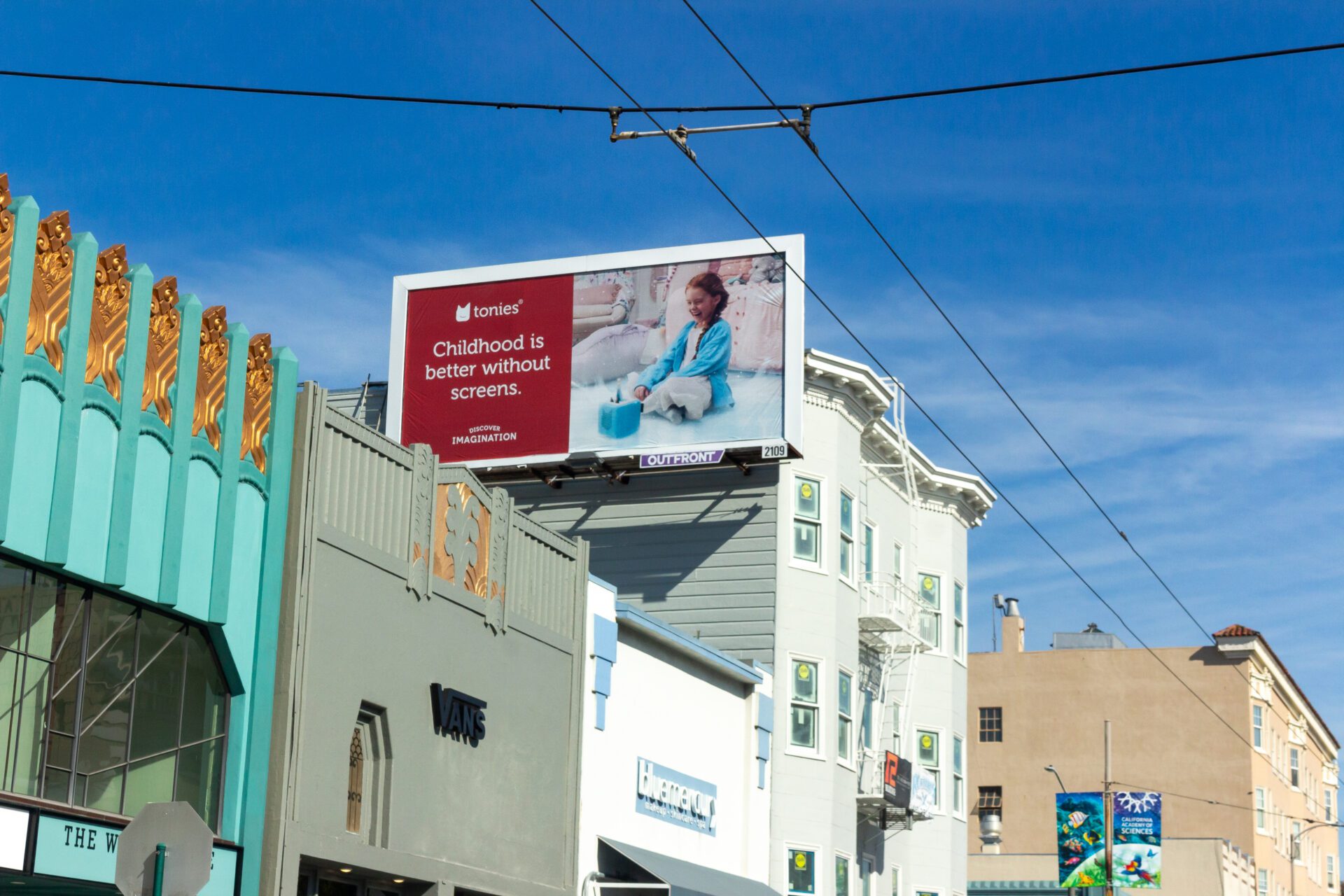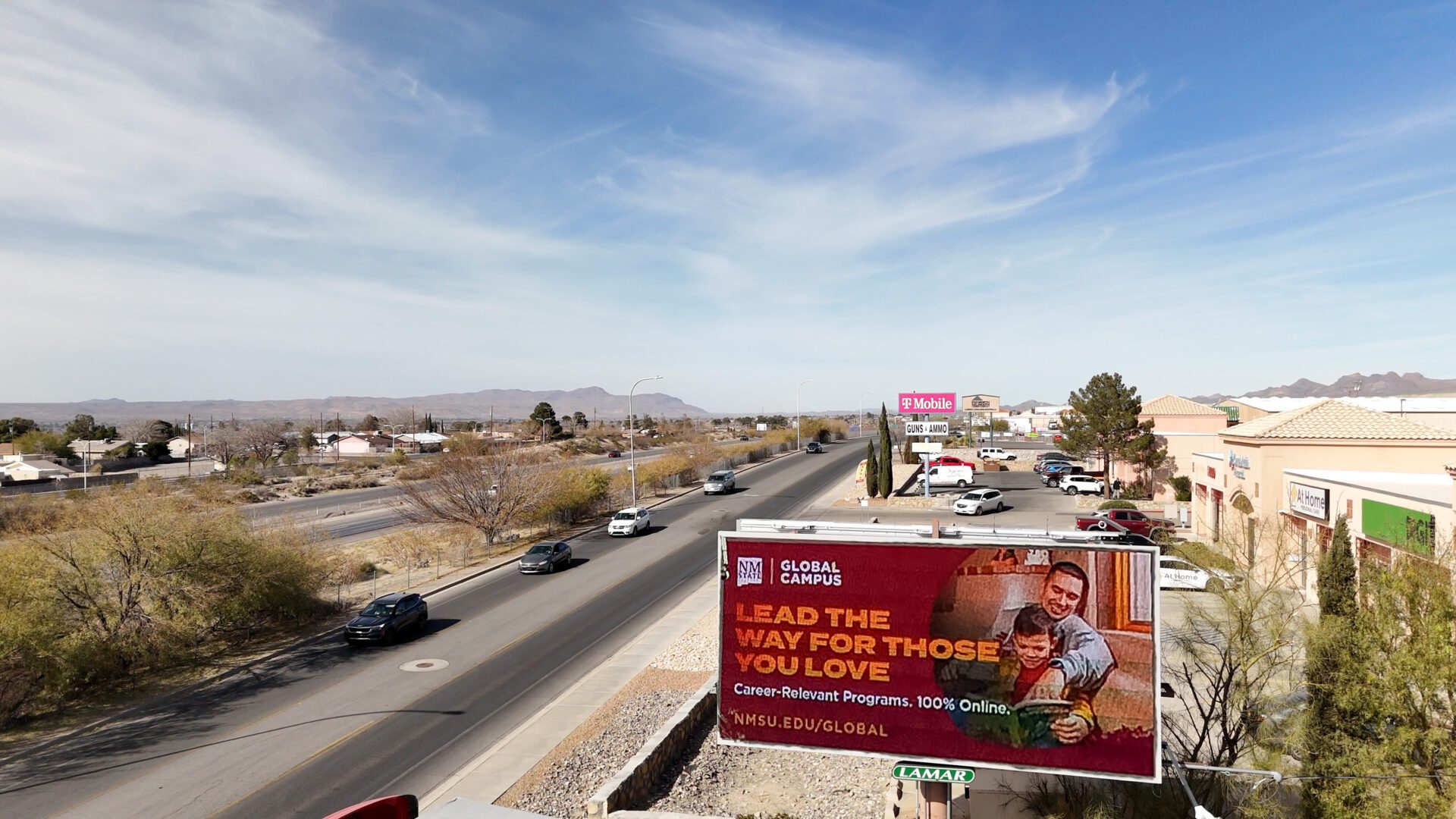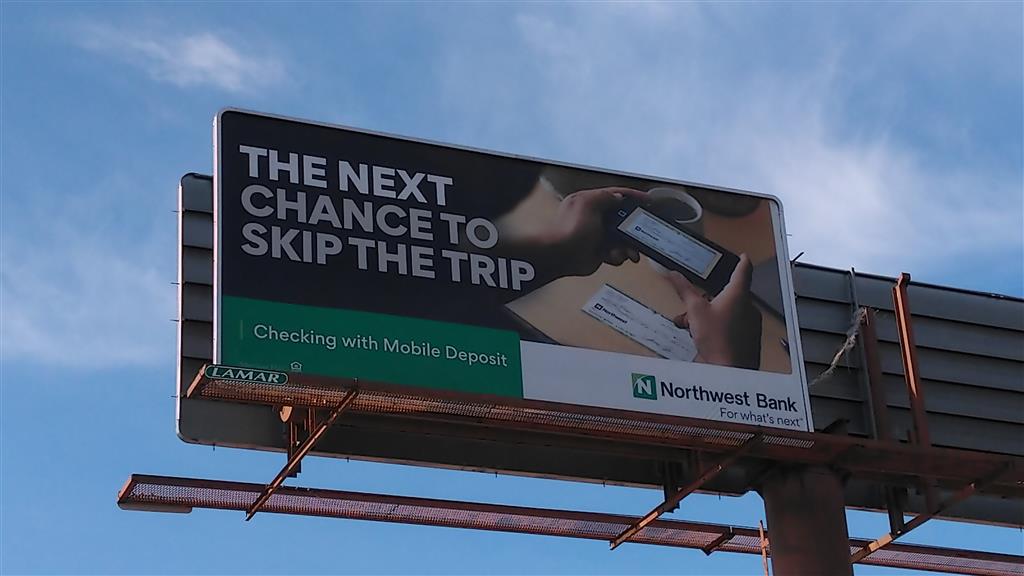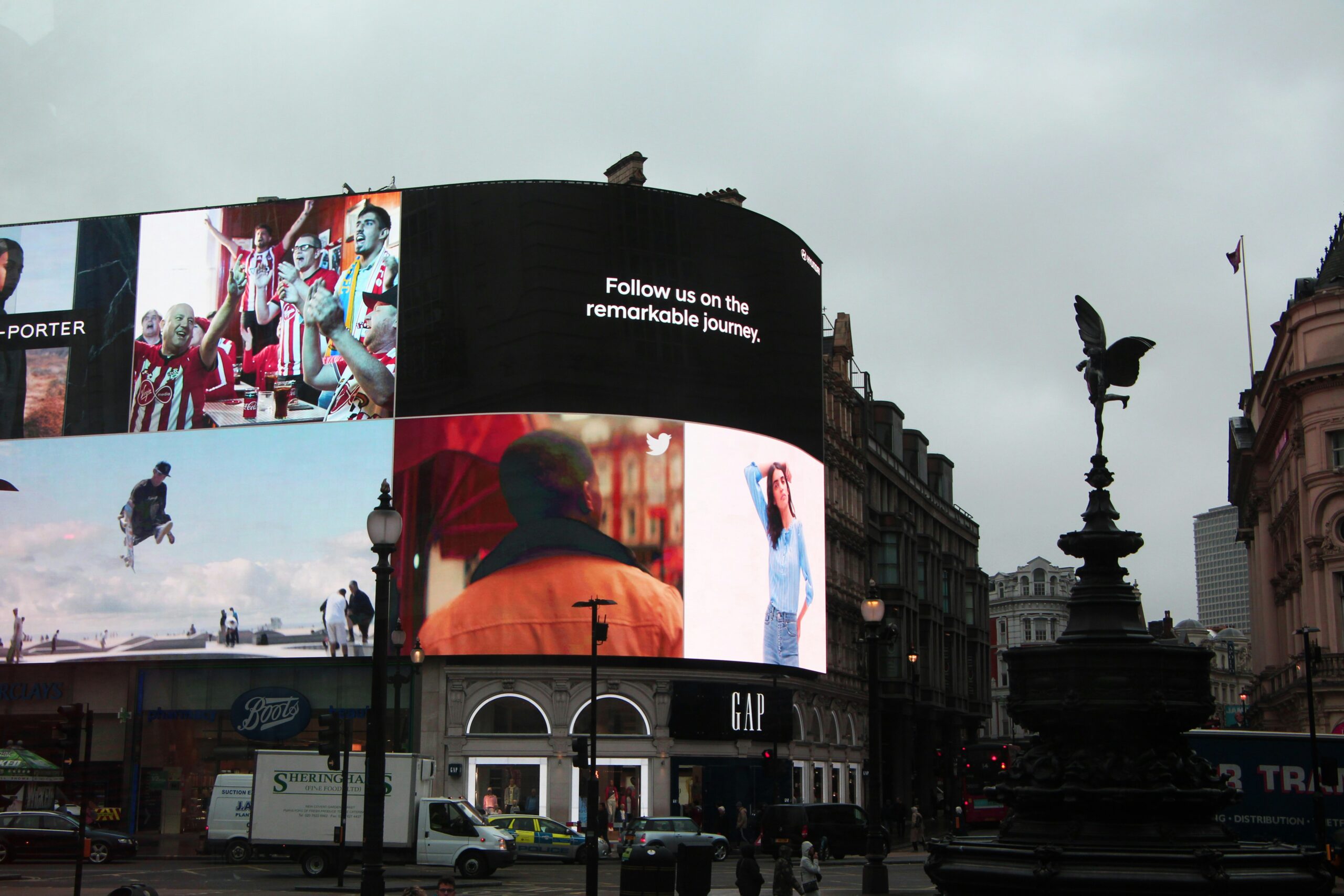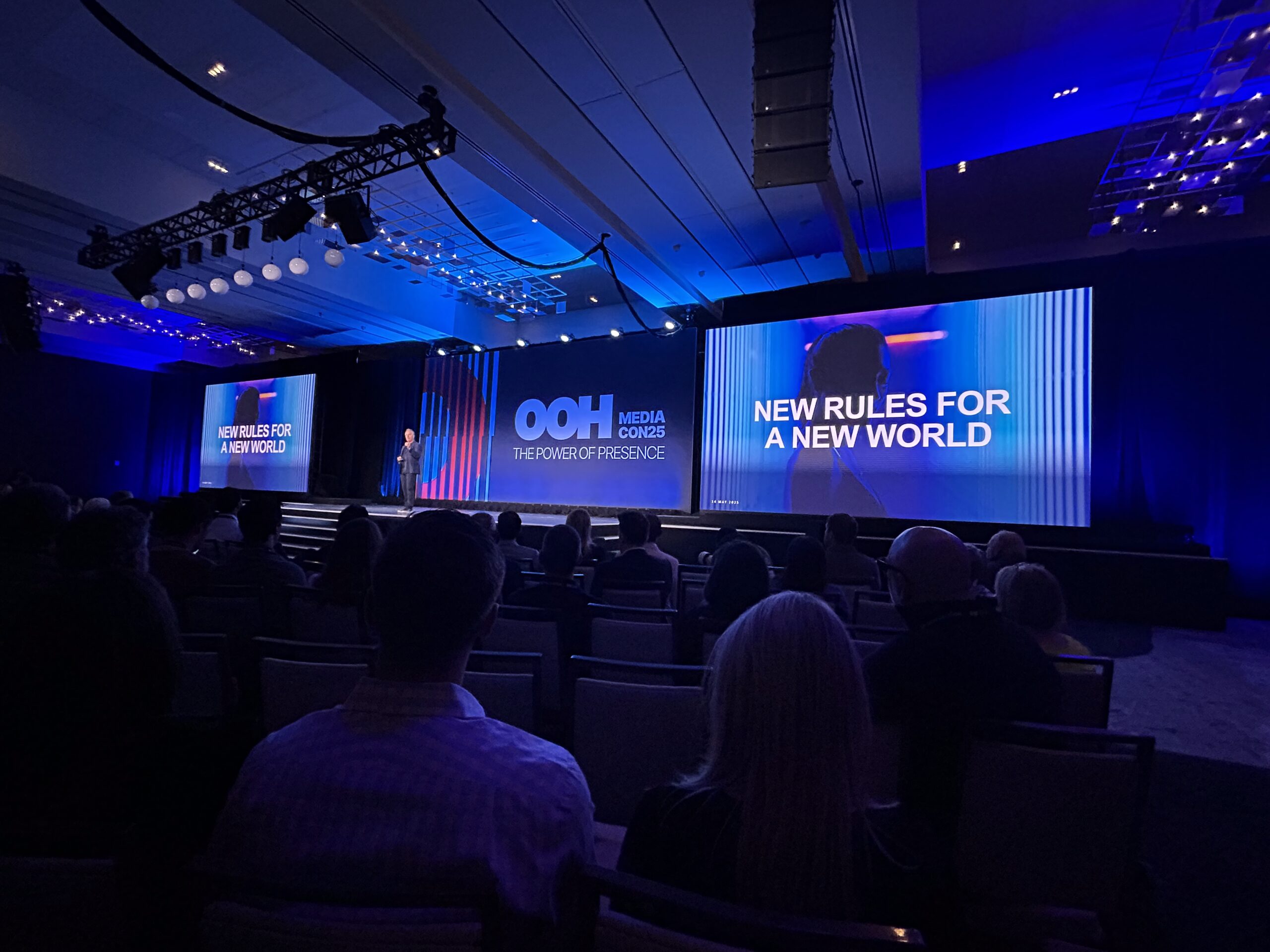Poster ads deliver brand beyond major auto traffic areas
While large-format billboards are great for major traffic pattern exposure, billboard poster ads are a versatile OOH format when the goal is to reach consumers deep in the neighborhoods where they live, work, and play.
Their placement and creative are especially visual along primary and secondary roads in commercial and industrial neighborhoods, which makes posters perfect for targeting local audiences, whether for commuters or on foot.
Typical Billboard Poster Sizes include:
• 10’x22′ standard canvases
• 6’x12′ junior canvases
47%
Noticed a Poster – Nearly half of Americans over 16 years old noticed a poster ad in the past month.
Source: NIELSEN
Frequently Asked Questions
How should I design the creative on my billboard advertisement?
Billboard ad creative should be designed with simplicity in mind as your audience may have a limited time of exposure to your creative. Don’t try to say too much, and only use a single call to action. A lot of times, someone seeing your ad will use a search engine look Google to look up your brand after the fact, showing up as direct organic traffic.
How should I determine the length of my OOH campaign?
Recommended program length will vary according to campaign objectives, and several example scenarios are provided below for reference. It is worth noting that to obtain statistical significance for measurement, a 4-week campaign duration is required. For a brand looking to establish their name in several major markets in the face of established competitors, we may recommend an always-on approach of several prime units that rotate quarterly with accompanying copy changes. For a seasonal effort to boost sales and reinforce a promotional offering, a 4-week blitz may be sufficient. To boost awareness among conference attendees, a campaign may be highly targeted in one specific area of the market and run for a week or less.
Are there minimum spend levels required for an Out of Home Campaign?
While there are no required minimum spend levels, there are thresholds below which buying OOH would not be recommended because impact would be too minimal. For example, one transit shelter in a major market like New York City will not provide adequate impact. Recommended spend level will also depend on program objectives. For example, a directionally-targeted OOH program for one retail location in a smaller market will cost far less than a seasonal promotional push to drive holiday sales across several major markets. One way we help advertisers determine ideal spend levels is by performing a TRP analysis, which factors in the market’s population as compared to the impressions generated by different types of formats to determine a recommended budget for adequate market penetration.
How much lead time is needed for planning an OOH campaign?
Lead times will vary according to format type and program objectives. A general market, digital format-focused campaign can sometimes be planned in a week or less, while a highly targeted, multi-market, multi-format campaign with custom built embellishments, interactive capability or 3D anamorphic technology may require a lead time of 8-12 weeks. It’s important to remember that demand for specific markets and formats can also impact required lead time. Some high demand units (think Super Bowl, New Year’s Eve in Times Square, etc.) can begin selling out 6 months or further in advance. In general, it is ideal to begin the planning and budgeting process for your OOH campaign 2-3 months before your desired start date to allow enough time to find available units, obtain budget approvals, produce posting materials, and evaluate readability of creative concepts.
How do I choose the right OOH formats for my campaign?
Leave that to us! Onescreen specializes in recommending formats that drive results. Choosing the best formats for your campaign is a combination of art and science that we harness data and industry expertise to accomplish. Aspects that guide our format recommendations: Data: We use a multitude of data sources on traffic routes, originating zip codes, demographics, psychographics, professions, data on competitors and client-provided data to determine which formats are an ideal fit. Brand Safety and Personality: Formats should reflect the brand’s persona, values, and status. For example, a high profile, full motion digital spectacular may be a better fit for a designer handbag brand, while a place-based c-store displays may be a better fit for an energy drink brand. Target demographic: We consider which formats will resonate best with the target demographic based on their travel habits and lifestyle. For example, if we know the target demographic frequents certain malls, we’ll likely recommend displays in or around those locations. Creative capabilities: Different formats offer varying creative execution capabilities. Digital displays provide bright, eye-catching creative with dynamic creative change integrations such as weather or traffic-triggered creative executions or social media tie-ins. Some digital displays can incorporate 3D anamorphic technology for an immersive, larger than life experience. Static bulletins offer 100% share of voice and can be outfitted with extensions or custom-built embellishments that enhance impact and earned impressions. Program objectives: There is no one OOH format that is inherently “better” than another, rather it is a matter of which is the best fit for each campaign’s objectives. Top recommendations for a long-term brand awareness campaign will differ from a short-term, hyper-targeted campaign surrounding an event such as a conference or sporting event. Likewise, a recommendation for a product demo that requires an immersive, in-person experience will differ from a campaign whose primary objective is directional messaging to traffic near an advertiser’s retail location. Coverage: Recommended formats will vary according to which market/s are being targeted and which formats are available in specific target areas (i.e. target zip codes, ABM list, competitor locations, etc.). Some cities have a wide variety of transit and street furniture options (such as New York City), while others may be limited to more traditional formats such as bulletins. In some areas, bulletins are zoned out by law and alternative formats, such as LED trucks with customized routing, are better options. Campaign Parameters: Factors like budget and lead time impact format recommendations as well. If posting quickly and/or frequent copy changes are a top priority, digital OOH formats may be the best fit. If an advertiser is seeking 100% share of voice in a specific area, a high-profile spectacular with a custom-built embellishment may be preferable. If budget is tight, a shorter-term program focused on alternative, experiential formats or targeted street furniture may work best. Personal Preference: When possible (if availability and budget allow) we take into consideration client format preferences. If multiple formats exist that are a good fit, some clients will prefer traditional formats such as bulletins, and others may prefer large format transit wraps or street furniture.
Besides billboards, what different types of OOH formats exist?
There are many different formats that fall under the umbrella of out-of-home. A basic breakdown of format categories is listed below, though it is by no means an exhaustive list. Categories of OOH Formats: Traditional OOH (Digital and Static): Fixed-location static and digital bulletins, spectaculars and posters provide targetable, highly visible exposure, and can deliver dynamic, attention-grabbing content. Posters are slightly smaller roadside displays that effectively permeate local neighborhoods. Transit and Moving Vehicle Advertising: Displays in and on buses, subways, rail systems, transit stations, taxis and rideshares engage commuters, reaching audiences in transit as well as nearby pedestrian and vehicular traffic. Other moving vehicle formats such as LED trucks or delivery trucks offer varying degrees of targetability and can be used to blanket a market or provide hyper-targeted exposure surrounding specific POIs. Street Furniture: Bus shelters, benches, and kiosks place ads in everyday public spaces, capturing attention during wait times and to passing pedestrian and vehicular traffic. Place-Based OOH: From airports to convenience stores to laundromats, grocery stores and malls, place-based advertising reaches consumers in a receptive mindset as they frequent their favorite local businesses. Alternative and Experiential OOH: Experiential OOH provides value through immersive experience (such as giveaways or fun events) to foster deep engagement and brand affinity. Alternative OOH “stunts” generate highly shareable, buzzworthy moments to drive earned impressions via social media or press coverage. A few examples in this category include custom pop-up shops, flash mob events, street teams and sidewalk chalking.
Can OOH be measured? How?
Yes! There are a variety of ways to measure the performance of your OOH campaign, depending on the type of client, program objectives and preferred formats. Weblift Measurement: Uses data from mobile devices and geolocation analytics to measure the impact of OOH on landing page and conversion page traffic by comparing the behavior of the exposed audience against a control group. Footfall Analysis: Assesses the impact of OOH on store visits by measuring how many people visit a physical store (or any other location) after having been exposed to an OOH ad. App Download Measurement: Measures app download lift after exposure to an OOH campaign. Brand Studies: Measures the impact of OOH on aspects such as brand sentiment, recall, engagement and intent to purchase by serving surveys to exposed audiences. Sales Lift: Measures purchase rate lift in exposed vs. control groups, or overall sales lift in markets where OOH campaigns were running. Device ID Passback: Allows advertisers to retarget the anonymized mobile IDs of audiences exposed to their OOH ads to amplify the impact of their campaign.
How do I choose the right markets for my OOH campaign?
We use multiple data sources to help you determine which markets are an ideal fit for your campaign objectives, including: -Cost efficiency / TRP analysis: How much budget is required to make adequate impact? -Formats available and characteristics of the market: Is there a downtown with lots of pedestrian traffic, lots of sporting events, etc.? Are there a variety of preferred format options available that align with the brand’s personality? -Data: Using our proprietary platform, we’re able to isolate high indexing zip codes according to demographic parameters, determine top originating zip codes, rank markets by profession (profession titles), and leverage a variety of other data sources for in-depth industry and market insights. -Client-provided data such as sales data, target zip codes, retail locations, and competitor locations.
How are impressions reported in OOH?
Impressions in OOH are provided by Geopath, the industry’s impression auditing organization. Impressions are based on traffic volume and take into account other factors such as unit size, side of the road, distance from the road, angle to the road, speed of traffic and estimated dwell time. OOH impressions are reported on a weekly basis and can be added up to determine overall program delivery / gross impressions. Not all OOH formats are geopath-audited, and thus impressions cannot be reported for those formats, though sometimes media vendor-provided estimates or circulation figures (such as transit system ridership) can be provided. Some examples of non-audited formats are mobile billboards, station dominations, aerial banners, and experiential activations such as street teams or pop-up shops.
What is a TRP and how can it be used in OOH planning?
A target rating point (TRP) is a metric used to gauge the market penetration of an OOH campaign in reaching its target audience within a defined universe (typically a designated market area or “DMA”). A TRP represents the percentage of the target audience in a given market exposed to an ad over a specified timeframe according to the gross impressions it delivers. TRP is the product of reach (the percentage of the target audience exposed to an ad) and frequency (the number of times the target audience is exposed to the ad). TRPs consist of duplicative impressions and thus include repeated impressions among the same people over the course of a campaign. For example, if person A sees your ad 5 times over the course of a 4-week campaign, this would count as 5 impressions, even though it is the same person seeing the ad multiple times. Thus, the impressions used to calculate TRPs are not unique and are referred to as “gross” impressions. TRPs can be thought of as the estimated percentage of the target audience your campaign will be exposed to according to the gross impressions it delivers. For example, if your campaign delivers 100,000 impressions over the course of 1 week in a market with a population of 200,000, it is said to deliver a 50 weekly TRP, with delivered gross impressions equating to 50% of that market’s target audience. TRPs are cumulative over time and are typically calculated on a weekly basis, then added up to determine overall campaign TRP. For example, a 50 weekly TRP would add up to a 200 4-week TRP.
Do you only offer billboards?
While billboards, like the ones you see on major thruways, are a major OOH option and usually the most visible, there is a wide range of advertising inventory options to align with marketing goals. It’s about creativity and finding the range of inventory. This is why we’re inventory agnostic: we find the right mix of OOH inventory, be that digital OOH, street teams, posters, wallscapes, mobile trucks and more. Our recommendations are based on the client’s needs and goals.
Don’t people just pass by billboards and ignore them?
According to various studies, most people do pay attention to billboards. Neilson reported that 83% of targets check out billboards some of the time and 40% report that they read the message every single time they pass. Moreover, our own internal research shows that 33% of viewers search for a company after seeing an OOH ad.
Related Posts
Why Direct Mail and Out of Home Advertising Still Win in a Digital Marketing World
Direct mail and out-of-home (OOH) advertising are proving they’re far from outdated. In this episode of Beyond the Billboard, hosts Charlie Riley and Greg Wise spoke with Mike Gunderson, founder…
Why OOH is the Most Underrated Performance Channel of 2025
For too long, Out-of-Home (OOH) advertising has been pigeonholed as a “brand awareness only” play – think splashy billboards and subway takeovers that look great but offer little in the…
What We Learned at the OAAA 2025 Conference: Measurement, Modernization, and the Power of OOH
This week, the OneScreen.ai team attended the OAAA 2025 Conference in Boston — an event that brings together leaders across the out-of-home (OOH) advertising industry to discuss where the industry…
